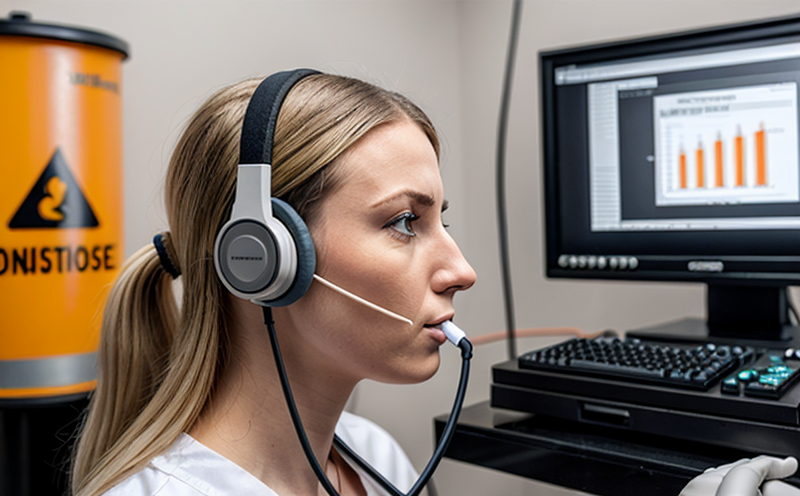EN 61672-2 Periodic Testing of Sound Level Meters
The European Standard EN 61672-2, issued by the European Committee for Standardization (CEN), provides comprehensive guidelines on periodic testing and calibration of sound level meters. This standard ensures that the equipment used in measuring noise levels is accurate, reliable, and compliant with international standards.
The periodic testing outlined in EN 61672-2 includes checks to verify the accuracy of the sound pressure level readings. The test covers a range of frequencies from 20 Hz to 20 kHz, which encompasses the audible spectrum for humans. The standard specifies that these tests are necessary for ensuring occupational health and safety in environments where noise can pose risks.
Sound level meters are crucial tools used by quality managers, compliance officers, R&D engineers, and procurement teams in various industries such as manufacturing, construction, and aerospace. In the context of acoustics, vibration, and noise testing, accurate sound pressure level measurements are essential for understanding ambient noise levels and their potential impact on workers' hearing.
The standard requires periodic testing to be conducted by accredited laboratories that follow a rigorous process to ensure accuracy and traceability. The tests involve exposing the sound level meters to a series of sound fields defined in the standard, each characterized by specific frequency bands and sound pressure levels. The performance of the meter is then compared against known reference values.
The periodic testing also includes checks for stability over time, ensuring that the instrument remains accurate even after extended use or storage. This aspect is critical for instruments used in occupational noise exposure assessments where consistency and reliability are paramount.
Compliance with EN 61672-2 helps organizations meet regulatory requirements and ensure worker safety. The standard plays a vital role in maintaining the integrity of sound level meter readings, which can significantly influence decisions regarding hearing protection and work environment improvements.
In summary, periodic testing according to EN 61672-2 ensures that the equipment used for measuring noise is accurate and reliable. This process is essential for protecting workers' hearing and complying with international standards in occupational health and safety.
Scope and Methodology
The scope of periodic testing as per EN 61672-2 encompasses a detailed series of procedures designed to assess the accuracy, stability, and linearity of sound level meters. The test includes several key components:
- Frequency Response Check: Ensures that the meter can accurately measure sounds over the frequency range from 20 Hz to 20 kHz.
- Linearity Check: Verifies that the meter provides a linear relationship between sound pressure level and instrument reading.
- Digital Display Stability Check: Tests the stability of the digital display against changes in ambient conditions.
- Repeatability Check: Evaluates the repeatability of readings under identical test conditions to ensure consistency over time.
The methodology involves exposing the sound level meter to a series of predefined sound fields, each characterized by specific frequency bands and sound pressure levels. The performance of the meter is then compared against known reference values provided in the standard.
The testing process is designed to be rigorous and comprehensive, ensuring that even minor variations are detected. This approach guarantees that the equipment remains accurate and reliable throughout its operational lifecycle. The results of these tests are reported in a detailed certificate, providing clear evidence of compliance with EN 61672-2.
Why Choose This Test
The periodic testing according to EN 61672-2 is essential for maintaining the accuracy and reliability of sound level meters, which are critical tools in occupational noise exposure assessments. Here’s why this test is important:
- Compliance with Standards: Compliance with international standards ensures that all measurements are accurate and consistent.
- Precision in Measurements: Ensures precise measurement of sound pressure levels, which is crucial for assessing noise exposure accurately.
- Worker Safety: Accurate measurements help identify hazardous noise levels, enabling appropriate measures to protect workers’ hearing.
- Regulatory Requirements: Many industries are required by law to comply with occupational health and safety regulations, which include periodic testing of sound level meters.
- Consistency in Data: Ensures that data collected over time is consistent, providing a reliable basis for decision-making.
- Avoidance of Errors: Regular testing minimizes the risk of errors due to instrument drift or malfunction.
- Confidence in Results: Accurate and reliable measurements instill confidence in the results, facilitating better-informed decisions.
By choosing this test, organizations demonstrate their commitment to occupational health and safety. The periodic testing ensures that sound level meters remain accurate and reliable, which is critical for protecting workers' hearing and complying with regulatory requirements.
Customer Impact and Satisfaction
The periodic testing of sound level meters according to EN 61672-2 has a significant impact on customer satisfaction and operational efficiency. Here’s how:
- Increase in Safety: Accurate noise measurements lead to better protection of workers' hearing, enhancing overall safety.
- Enhanced Accuracy: Regular testing ensures that the meters remain accurate, leading to more reliable data and informed decisions.
- Compliance with Regulations: Meeting international standards helps organizations comply with regulatory requirements, avoiding legal issues.
- Improved Reputation: Demonstrating a commitment to occupational health and safety enhances an organization's reputation.
- Cost Efficiency: By identifying potential issues early, periodic testing can prevent costly errors or equipment failures in the future.
- Customer Trust: Providing accurate and reliable data builds trust with customers and stakeholders.
Customers benefit from improved accuracy, compliance, and safety measures. They also gain confidence in the reliability of the test results, which is crucial for making informed decisions regarding occupational noise exposure assessments.





